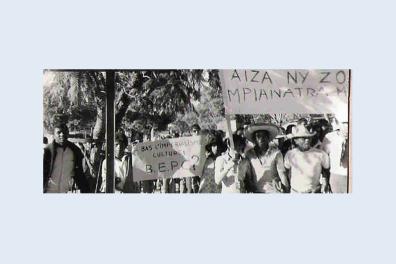Study day "Madagascar, May 1972: storytelling, words and images", April 13

Ville de Fianarantso © Noël GueunierJournée d'études organized by the Centre d'études en sciences sociales sur les mondes africains, américains et asiatiques - CESSMA (Inalco, Université Paris Cité, IRD).
Wednesday, April 13, 2022 - 09:00-17:30 - PLC Auditorium
Inalco, PLC - 65, rue des Grands Moulins - 75013 Paris
Free admission
Madagascar, May 1972: mises en récits, mises en mots et en images
As part of the 50th anniversary of the events of May '72 in Madagascar, this Study Day, which takes a dual sociolinguistic and historical perspective, aims, beyond commemoration, to explore new research perspectives in history, sociolinguistics, anthropology and other fields that enable scientific disciplines in SHS to connect.
May 1972, a historical era also called "the revolution" or "the second independence" by several historians (see bibliography), is described by Françoise Raison-Jourde (2011) as a local invention in the occupation of urban space and speaking out in the provinces for the Malagasy schoolboy of that era. Françoise Blum (2011, 63) speaks of revolt and points out that many things are tied up around the question of language, central to Madagascar, a producer of torn identities, unhappy consciences and the object of "excessive politicization". Irène Rabenoro (1995), in her dissertation entitled Le vocabulaire politique malgache pendant les évènements de Mai 1972 (Malagasy political vocabulary during the events of May 1972), focuses on the linguistic contributions of this period and, in the context of an analysis of political discourse, on the mentalities and values that prevailed. The importance of words in the Malagasy May revolution is unquestionable: words to say, to express oneself, to protest... Indeed, different modes of expression abounded in the public arena (writings, drawings, posters, songs, etc.) at a time when understanding reality in Malagasy had become a necessity. We also realize that, in the collective memory, these events seem to have been reduced to the Place du 13 mai in Antananarivo, "Kianjan'ny 13 mai", this emblematic place, located in front of the Hôtel de Ville, known since 1972 as the urban space of protest.
This study day is structured around questions concerning the events themselves, the words of those who experienced them as actors (biographical approach) and the views of these events. The day will be divided into three parts:
- Facts and memories: Without taking a census of the facts in the narratives, the aim is to characterize May 72. What are the questions raised by these historic moments?
- Dire, se dire, s'exprimer : Close-up on the various "expressions" of the actors and demonstrators of this historic era - signs, placards, inscriptions, drawings, literary texts, etc.- for putting into words the lived experience of these events and those of the demands.
- Contemporary readings and putting into words of May 72 : What are we saying about these events? What did they bring? Are they repressed in a distant past and symbolized by an urban space that has become a "memory"?
The event will be illustrated by a photo exhibition in the Foyer (in front of the auditorium) and followed by a sale of works by publishers l'Hémisphères and l'Harmattan.
Contacts: View e-mail / View e-mail

Madagascar, Mai 1972 : les mises en récits, les mises en mots et en images - Affiche (325.32 KB, .pdf)
Madagascar, Mai 1972 : les mises en récits, les mises en mots et en images - Programme et résumés des interventions (887.6 KB, .pdf)